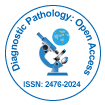Comparative immunohistochemical expression of TROP2 in brain metastatic and primary tumors
Received Date: Jul 31, 2025 / Accepted Date: Sep 01, 2025 / Published Date: Sep 01, 2025
Abstract
Background: TROP2 overexpression was reported to predict poor prognosis and increased metastatic potential. This study evaluates TROP2 expression in brain metastases from diverse solid tumors and its consistency with primary tumors, addressing the limited research on TROP2 heterogeneity and its implications for CNS-targeted therapies.
Methods: TROP2 immunohistochemical staining was performed on 61 brain metastatic tumors and 14 corresponding primary tumors. Based on TROP2 expression, cases were categorized into three groups: Diffuse positive (>95%), focal positive (0-95%) and negative (0%).
Results: Among the 61 brain metastatic tumors, TROP2 expression was diffusely positive in 62.3%, focally positive in 16.4% and negative in 21.3%. Diffuse TROP2 positivity was most observed in tumors of lung origin, while focal positivity was predominant in colorectal metastases. In terms of pathologic diagnosis, adenocarcinoma was the most common type, with 55.6% showing diffuse positivity, 33.3% showing focal positivity and 11.1% showing negativity. Notably, all cases of Invasive Breast Carcinoma of No Special Type (IBC-NST) exhibited diffuse TROP2
positivity. No significant association was found between TROP2 expression levels and post-CNS metastasis survival. In the paired analysis of 14 cases with both primary and metastatic tumors, TROP2 expression was consistent between primary and metastatic sites in 78.6% of cases. However, 21.4% of cases, including colorectal adenocarcinoma and kidney clear cell carcinoma, showed discordant expression patterns between the primary and metastatic lesions.
Conclusion: This study demonstrated variable TROP2 expression in brain metastasis samples and confirmed high consistency of TROP2 expression between primary and brain metastatic lesions.
Keywords: TROP2, Brain metastasis, Immunohistochemistry, Cancer, Primary tumor
Citation: Sung YN, Sim J, Oh H, Lee JW, Kim JH, et al. (2025) Comparative Immunohistochemical Expression of TROP2 in Brain Metastatic and PrimaryTumors. Diagnos Pathol Open 10:250.
Copyright: © 2025 Sung YN, et al. This is an open-access article distributed under the terms of the Creative Commons Attribution License, which permits unrestricted use, distribution and reproduction in any medium, provided the original author and source are credited.
Select your language of interest to view the total content in your interested language
Share This Article
Open Access Journals
Article Usage
- Total views: 1603
- [From(publication date): 0-0 - Dec 09, 2025]
- Breakdown by view type
- HTML page views: 1477
- PDF downloads: 126
